My Approach to Automatic Musical Composition
In this blog, I will introduce my approach to automatic musical composition, including the theory, the algorithm, and a Python package implementation ch0p1n.
What Is Automatic Composition?
Automatic composition is using algorithms to generate music.
As a trivial example, imagine that you put a cat on a piano to randomly press keys to generate music. The music is thus the result of a predetermined algorithm rather than of your instantaneous emotions or compositional skills. This is why it is called automatic composition.
Automatic composition has many different approaches or paradigms.1 The approach I take is inspired by the theories of Arnold Schoenberg, Heinrich Schenker and William Caplin. The key idea is that music can develop or be generated from limited materials under some common operations. I will explain the theoretical foundation of my approach in the following three sections.
Generate Music from Limited Materials
Let’s see an example, the beginning of Beethoven’s first piano sonata:
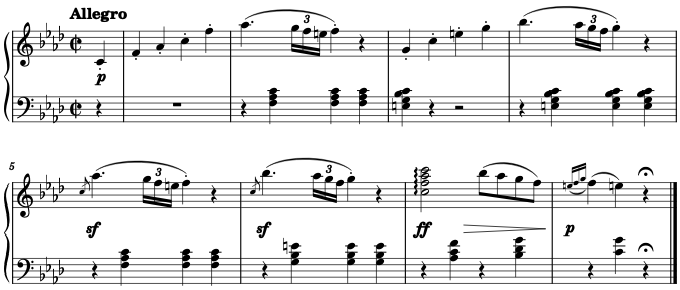
As indicated below, the two framed structures are almost identical:

In fact, the structure in the blue frame can be generated by merely transposing the structure in the red one. Therefore, to compose this piece, I need only to create the structure in the red frame, then reuse or slightly modify it to generate the structure in the blue frame, rather than create both structures from scratch.
The same situation happens in other parts too. As indicated below, the four framed structures are also highly similar:

Does this kind of reuse exist only in Beethoven’s music? No, this probably happens in every musical work. No matter how long a musical work lasts or how varied it can sound, the amount of its core materials is always small.
For another example, the following is an excerpt from Mozart’s K. 485:
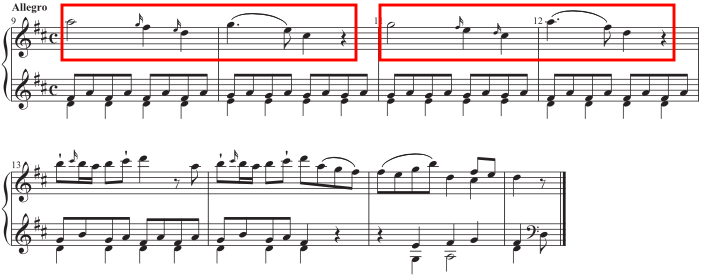
Sometimes, however, a material can be modified so much that you can barely recognize it, as in the following example, the beginning of Chopin’s nocturne Op.9 No.1:
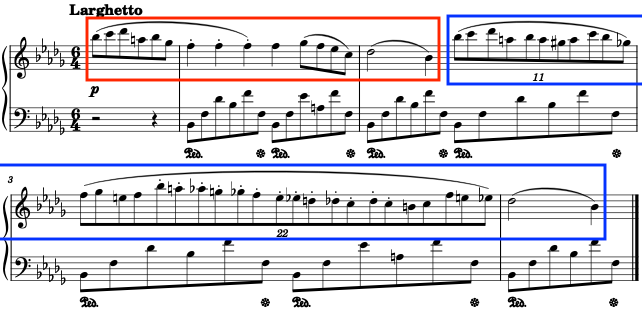
The two framed structures look and sound quite different, but, in my approach, it is still that the structure in the blue frame can be generated by elaborating the structure in the red one, rather than that they are totally unrelated. It is so because the two structures have some morphological characteristics in common, they have the same background harmonic progression, and from the perspective of musical form, the structure in the blue frame is indeed a repetition of the structure in the red one.2
Please note that, in stating that a structure can be generated from other structure, I do not assert that Beethoven or Chopin actually did this or deliberately did this when composing music. Rather, my point is that we can use this music generation perspective to formalize or automate the process of musical composition.
Common Operations to Manipulate Materials
Once a structure is created, some common operations can be applied to them to generate new structures. I will talk about some operations below.
The first operation I will talk about is repetition. It means repeating a structure in a new harmony without changing its morphology.
The Beethoven’s sonata is an example of repetition:

The structure in the blue frame is a transposition of the structure in the red one. The two structures have the same morphology, although they are adapted to different background harmonies.
The Chopin’s nocturne is another example. The accompaniment motif in the blue frame is a repetition of the one in the red frame:

In the repetition, some pitches move to their nearest pitches to fit the new harmony, according to some voice-leading rules.3 Some of these changes are indicated below:

The next operation is elaboration. It means adding passing notes, neighbor notes, and other types of notes to a structure. The Chopin’s nocturne is an example, in which a lot of tuplets are added in the repetition:

Sometimes, elaborations are rather inferred from than showed in scores. Heinrich Schenker’s theory differentiates music’s superficial structure from its deep structure(s), and the superficial structure is the outcome of elaboration of a deep structure, as showed in the following example:4
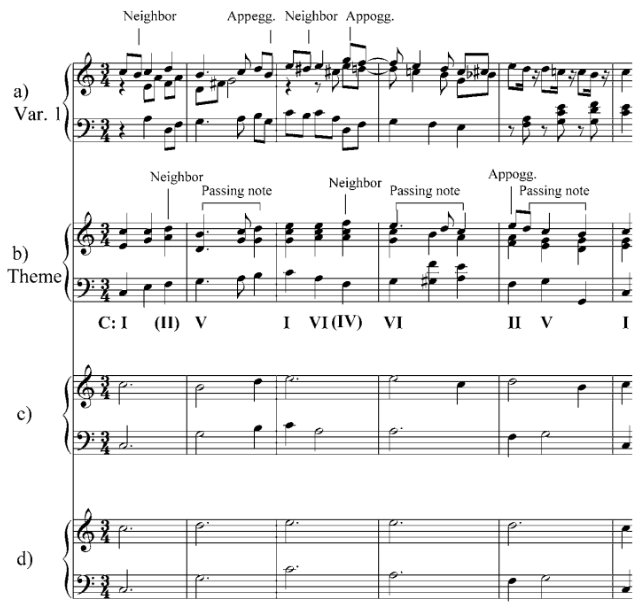
In the above score, for example, piece b can be generated by elaborating piece c.
The opposite operation of elaboration is reduction. For example, in the above score, piece b can be reduced to piece c.
The last operation I will talk about is fragmentation. It means taking a fragment from a material.
As in the Beethoven’s sonata, the structure in the blue frame is a fragment from the structure in the red one:

The Chopin’s nocturne is a more interesting example:
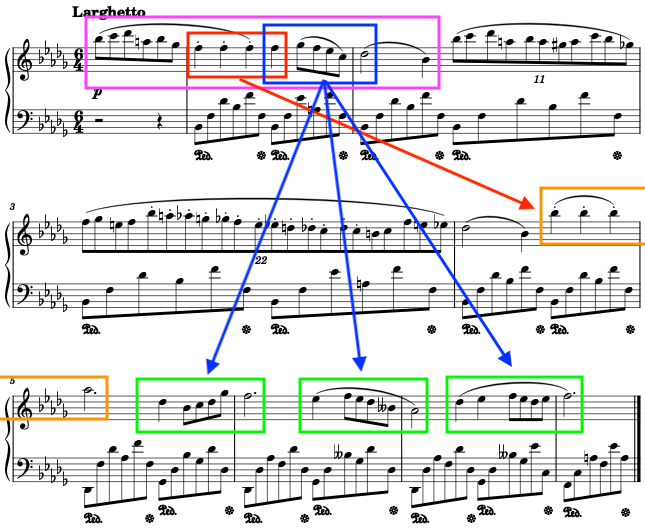
The fragment in the red frame can be modified to generate the structure in the orange frame; the fragment in the blue frame can be modified to generate the structures in the green frames. The two fragments are taken from the structure in the purple frame.
There are more operations can be applied to musical materials, but I will stop here. The four operations I have introduced are enough for the purpose of this blog.
Combine Materials According to Musical Forms
Created and generated structures can be combined into larger structures, according to musical forms. A musical form is a way in which musical materials should be organized.
For example, the beginning of the Beethoven’s sonata has the form sentence. Below is how this sentence is analyzed in William Caplin’s system:2
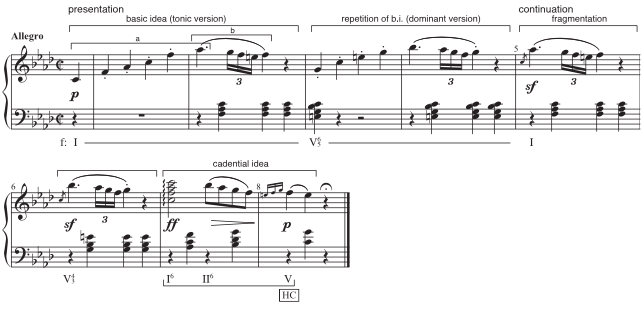
The beginning of the Chopin’s nocturne is from a larger structure of the form compound period, which is far more complex than sentence.
I will not go deep into the subject of musical forms here. I highly recommend William Caplin’s excellent textbook2 on this topic. My key point is that musical materials should be combined according to musical forms to generate meaningful music.
Summary of the Theoretical Foundation
There are three key concepts in the theory behind my approach:
- limited core materials, from which more materials can be generated,
- common operations, which can be applied to materials to generate more, and
- musical forms, according to which materials should be combined.
Now it is time to turn the theory into an algorithm.
Represent Musical Structures
We first need to strictly define musical materials and structures, which we have been talking about quite vaguely.
Let’s return to the Beethoven’s sonata. Below is its first two bars:
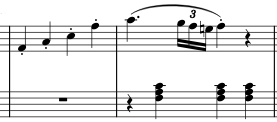
This piece of music has two voices or musical lines. Each musical line consists of notes, rests or chords which consist of notes too. A note has several attributes, among which only pitch and duration will be considered here. Rather than represent notes as single objects, we will handle their pitch and durational contents separately.
Pitches can be represented by scientific pitch notations or MIDI note numbers. Mostly, the latter are used, for ease of operation. For example, pitch C4 is represented by MIDI note number 60.
The pitch content of a rest can be represented by None in Python.
The pitch contents of a chord can be represented by list in Python. For example, in Python we can use ['C4', 'A-3', 'F3'] or [60, 56, 53] to represent the pitch contents of the chord in the red frame:

Durations can be represented by numbers. For example, quarter note’s duration is 1.
The pitch contents of a musical line can be represented by what I call pitch line. In Python, a pitch line is a list whose members are None, numbers or lists of numbers. With Python package typing, pitch line can be defined as:
from typing import List, Union
Pitch = int
PitchLine = List[Union[None, Pitch, List[Pitch]]]
The durational contents of a musical line can be represented by duration line. In Python, a duration line is a list whose members are numbers.
Finally, harmonies and scales can be represented by lists of pitch classes. For example, in Python C major harmony can be represented by ['C', 'E', 'G'] or [0, 4, 7].
Motifs
You may have heard this term a lot. A motif is structurally a musical line, usually short in length. Motifs are the building blocks of music. They can be repeated, elaborated, fragmented and combined to generate music.
For example, the following is how Schoenberg analysed the beginning of the Beethoven’s sonata:5

In his analysis, the melody part of this piece can be generated from only three motifs.
There are different kinds of motifs. For example, two kinds of motifs are framed in the following score:

The motifs in the red frames can be called accompaniment motifs as they appear in the accompaniment line of this nocturne. They can also be called harmonic motifs as they consist of only harmonic notes. The motifs in the blue frames can be called melodic motifs as they appear in the melody line, or non-harmonic motifs if they contain non-harmonic notes.
In the following several sections, I will talk about the implementation of the common operations that can be applied to motifs.
Implementation of Repetition: transpose()
The function transpose() from my Python package ch0p1n is for transposing a motif along a scale.
Suppose there is a motif which can be represented as:
pitch_motif = [60, 67, 76, 72]
# ['C4', 'G4', 'E5', 'C5']
duration_motif = [1, 1, 1, 1]
Remember that we separately represent a motif’s pitch and durational contents.
We can show this motif in score with show(), which is built on Python package music21:
from ch0p1n.utils import show
show(
pitch_lines = [pitch_motif],
duration_lines = [duration_motif],
group = 1, # the number of voices in the treble staff
key = 0,
meter = '4/4',
clefs = ['g', 'f']
)

Transpose it up by one step along the C major scale:
from ch0p1n.motif import transpose
pitch_motif_transposed = transpose(
pitch_motif = pitch_motif,
scale = [0, 2, 4, 5, 7, 9, 11],
step = 1
)
The code is pretty self-explanatory. Let’s check the result:
>>> pitch_motif_transposed
[62, 69, 77, 74]
show(
pitch_lines = [pitch_motif_transposed],
duration_lines = [duration_motif],
group = 1, # the number of voices in the treble staff
key = 0,
meter = '4/4',
clefs = ['g', 'f']
)

It looks good. Every pitch has moved up by one step along the C major scale.
Since harmony is a special kind of scale, we can use transpose() to repeat the motif in a harmony, say, the G major harmony:
pitch_motif_transposed = transpose(
pitch_motif = pitch_motif,
scale = [7, 11, 2], # G major harmony
step = 1
)
Let’s show the original and the transposed motifs together:
show(
pitch_lines = [pitch_motif + pitch_motif_transposed],
duration_lines = [duration_motif * 2],
group = 1,
key = 0,
meter = '4/4',
clefs = ['g', 'f']
)

The original motif is in the first bar, and the transposed the second. You can see how each pitch moves up by one step in the G major harmony.
In some cases, however, transpose() does not work well. Still in the above example, suppose we transpose the motif down rather than up by one step with step = -1:

The transposed motif in the second bar is not acceptable because it contains no pitch class G to fully reify the G major harmony.
Implementation of Repetition: lead()
We can improve this situation with function lead() from ch0p1n. The function got its name from the concept of voice-leading, which means every note in a motif leads by step to the note(s) in a given harmony.
Let’s give it a try:
from ch0p1n.motif import lead
pitch_motifs = lead(
pitch_motif = pitch_motif,
harmony = [7, 11, 2], # G major harmony
steps = [-1, 0],
complete = False,
similar = None
)
steps = [-1, 0] means each pitch will move zero step if it fits the harmony, and at the same time one step downwards. In other words, each pitch may generate more than one pitch in the given harmony under lead(), and the result returned is thus a list of pitch motifs rather than a single one. I will talk about parameters complete and similar later.
Let’s check the result:
>>> pitch_motifs
[
[59, 62, 74, 71],
[59, 67, 74, 71]
]
There are two pitch motifs generated. Let’s show them in score:
# to merge `pitch_motifs`
from itertools import chain
show(
pitch_lines = [list(chain(*pitch_motifs))],
duration_lines = [duration_motif * 2],
group = 1,
key = 0,
meter = '4/4',
clefs = ['g', 'f']
)

While the motif in the first bar is as same as the unacceptable one generated by transpose() with step = -1, the motif in the second bar is good, which fully reifies the G major harmony.
With complete = True, we can screen out the pitch motifs which are not harmonically complete or do not fully reify the given harmony:
pitch_motifs = lead(
pitch_motif = pitch_motif,
harmony = [7, 11, 2],
steps = [-1, 0],
complete = True,
similar = None
)
Now there leaves only one pitch motif, the good one:
>>> pitch_motifs
[
[59, 67, 74, 71]
]
With parameter similar, we can screen out the pitch motifs which do not have the same contour as the original one. I will skip this part in this introductory blog.
Implementation of Repetition: thread()
The function thread() is for repeating a motif in consecutive harmonies or threading a motif through harmonies. Let’s try it on the motif defined earlier:
from ch0p1n.motif import thread
pitch_motifs = thread(
pitch_motif = pitch_motif,
duration_motif = duration_motif,
harmonies = [[5, 9, 0], [7, 11, 2]], # F, G
durations = [2, 2],
steps = [1]
)
show(
pitch_lines = pitch_motifs,
duration_lines = [duration_motif],
group = 1,
key = 0,
meter = '2/4',
clefs = ['g', 'f']
)

The first two notes of the motif are adapted to the F major harmony, while the last two notes to the G major harmony.
So far, I have talked only about harmonic motifs. To deal with non-harmonic motifs, which is more complex, we need first to consider how to elaborate motifs.
Implementation of Elaboration
Simply speaking, elaboration is adding notes to a motif. The function elaborate() from ch0p1n serves the exact purpose.
Let’s try it on the motif defined earlier:
from ch0p1n.motif import elaborate
motif = elaborate(
pitch_motif = pitch_motif,
duration_motif = duration_motif,
reference = 2,
steps = [-1, -1],
scale = [0, 2, 4, 5, 7, 9, 11],
position = 'left'
)
Show the original and the elaborated motifs together:
show(
pitch_lines = [pitch_motif + motif[0]],
duration_lines = [duration_motif + motif[1]],
group = 1,
key = 0,
meter = '4/4',
clefs = ['g', 'f']
)

Two notes are prepended to the third note.
Let’s have a look at the code.
The argument reference indicates where to add notes or elaborate the motif. For example, reference = 2 means the notes are added at the third note. We can elaborate the last note instead:
motif = elaborate(
pitch_motif = pitch_motif,
duration_motif = duration_motif,
reference = 3, # the last note
steps = [-1, -1],
scale = [0, 2, 4, 5, 7, 9, 11],
position = 'left'
)

The argument steps specifies the pitches of the notes to add. For example, steps = [-1, -1] indicates that the reference note should move one step downwards to generate the first note, then this note should move one step downwards to generate the second note. Let’s add three descending notes with this argument:
motif = elaborate(
pitch_motif = pitch_motif,
duration_motif = duration_motif,
reference = 2,
steps = [1, 1, 1], # three descending notes
scale = [0, 2, 4, 5, 7, 9, 11],
position = 'left'
)

With steps, you can also repeat some note or add rests to a motif, as in the following example:
motif = elaborate(
pitch_motif = pitch_motif,
duration_motif = duration_motif,
reference = 2,
steps = [0, 0, None] # repeat the note twice then add a rest
)

The argument scale specifies the scale along which to move the reference note to generate the notes to add. For example, scale = [0, 2, 4, 5, 7, 9, 11] indicates that it is the C major scale. We can use C chromatic scale instead:
motif = elaborate(
pitch_motif = pitch_motif,
duration_motif = duration_motif,
reference = 2,
steps = [-1, -1],
scale = list(range(12)), # C chromatic scale
position = 'left'
)

The argument position specifies the position of the added notes relative to the reference note. For example, position = 'left' indicates that the notes are added at the left side of the reference note. We can add the notes at the right side:
motif = elaborate(
pitch_motif = pitch_motif,
duration_motif = duration_motif,
reference = 2,
steps = [-1, -1],
scale = [0, 2, 4, 5, 7, 9, 11],
position = 'right' # add the notes at the right side
)

Please note that, with 'left' and 'right', the added notes take durations from the reference note. If you want that the durations are taken from the note before or after the reference note, use 'previous' or 'next'. For example,
motif = elaborate(
pitch_motif = pitch_motif,
duration_motif = duration_motif,
reference = 2,
steps = [-1, -1],
scale = [0, 2, 4, 5, 7, 9, 11],
position = 'previous' # take durations from the previous note
)

The argument ratio specifies the percentage of duration the added notes take. For example, ratio = 1/2 means that the added notes take 50% of the duration of the reference note:
motif = elaborate(
pitch_motif = pitch_motif,
duration_motif = duration_motif,
reference = 2,
steps = [-1, -1],
scale = [0, 2, 4, 5, 7, 9, 11],
position = 'left',
ratio = 1/2 # take 50% of the duration of the reference note
)

Implementation of Reduction
Reduction is the opposite of elaboration. It is removing notes from a motif. The corresponding function from ch0p1n is reduce().
Take the last motif from the previous section as an example:

Reduce it to the unelaborated version:
from ch0p1n.motif import reduce
motif = reduce(
pitch_motif = motif[0],
duration_motif = motif[1],
start = 2,
end = 3,
position = 'right'
)
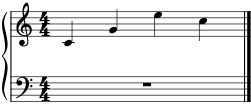
The arguments start and end specify the notes to remove. The argument position specifies the reference note to which to add the durations of the removed notes.
Repeat Non-Harmonic Motifs
Non-harmonic motifs contain non-harmonic notes. For example, the following is a non-harmonic motif:

The background harmony is Fm, and the circled notes are non-harmonic since they do not fit the harmony.
To repeat a non-harmonic motif,
- reduce it to contain only harmonic notes,
- repeat the reduced motif, and
- elaborate the repeated motif.
Let’s try this strategy on this motif.
This motif can be represented as:
pitch_motif = [65, 68, 72, 77, 80, 79, 77, 76, 77, None]
duration_motif = [1, 1, 1, 1, 1.5, 1/6, 1/6, 1/6, 1, 1]
Reduce it:
pitch_motif, duration_motif = reduce(
pitch_motif,
duration_motif,
start = 5,
end = 7,
position = 'left'
)
# the same below
show(
[pitch_motif],
[duration_motif],
key = -4
)

Repeat it in C7 harmony:
pitch_motif = transpose(pitch_motif, [0, 4, 7, 10], 1)

Finally, elaborate it:
pitch_motif, duration_motif = elaborate(
pitch_motif,
duration_motif,
reference = 4,
steps = [-1, -1, -1],
scale = [5, 7, 8, 10, 0, 1, 4],
position = 'right',
ratio = 1/4
)

Implementation of Fragmentation: divide()
Fragmentation is breaking a motif up into several shorter motifs or taking a fragment from a motif. The corresponding functions from ch0p1n are divide() and fragment().
Consider the following motif from the Chopin’s nocturne:

This motif can be represented as:
pitch_motif = [82, 84, 85, 81, 82, 78] + [77]*4 + [78, 77, 75, 72, 73, 70]
duration_motif = [0.5]*6 + [1]*4 + [0.5]*4 + [2, 1]
With divide(), we can divide this motif into, say, three shorter motifs of equal length:
from ch0p1n.motif import divide
motifs = divide(pitch_motif, duration_motif, 3)
>>> motifs
[
([82, 84, 85, 81, 82, 78, 77], [0.5, 0.5, 0.5, 0.5, 0.5, 0.5, 1]),
([77, 77, 77, 78, 77], [1, 1, 1, 0.5, 0.5]),
([75, 72, 73, 70], [0.5, 0.5, 2, 1])
]
for motif in motifs:
show([motif[0]], [motif[1]], key = -5)
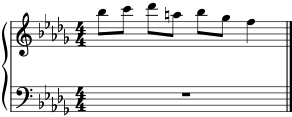
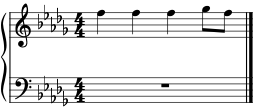

Implementation of Fragmentation: fragment()
With fragment(), we can take a fragment from a motif. For example,
from ch0p1n.motif import fragment
motif = fragment(
pitch_motif,
duration_motif,
start = 6,
end = 9,
ratio = 1/2,
fit = 'right'
)
show([motif[0]], [motif[1]], key = -5, meter = '6/4')
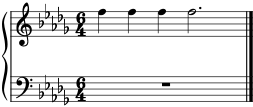
The arguments start and end specify the start note and the end note of the fragment. ratio = 1/2 indicates that the fragment’s length should be 50% of the original motif, and to accomplish this, fit = 'right' indicates that the end note should be prolonged.
Case Study: Replicate and Vary Beethoven’s Sonata
Now it is time to put it all together. Let’s first try to generate the beginning of the Beethoven’s sonata from a small amount of materials, under the operations that we have been talking about.
To simplify the problem and to make patterns more discernible, I will remove slurs, articulations, dynamics, grace notes, and some other notes from the original score:
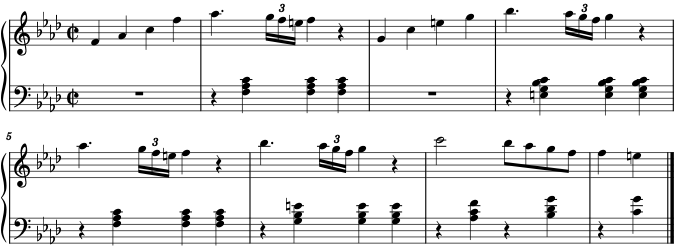
This piece consists of two voices or musical lines, the melody line in the treble staff and the accompaniment line in the bass staff.
The melody line, in my analysis, consists of seven melodic motifs, as indicated below:

And all of them can be generated from the following melodic motif:

The accompaniment line consists of seven accompaniment motifs:

And these motifs can be generated from:

In summary, to generate the beginning of the Beethoven’s sonata, the core materials are
- the melodic motif to generate the melody line,
- the accompaniment motif to generate the accompaniment line,
- harmonies for repetition of motifs, and
- the scale for elaboration of motifs.
Let’s turn this analysis into code.
Represent the core melodic motif:
melodic_pitch_motif = [65, 68, 72, 77, 80, 77]
melodic_duration_motif = [1, 1, 1, 1, 2, 2]
Represent the core accompaniment motif:
accompaniment_pitch_motif = [[60, 56, 53]]
accompaniment_duration_motif = [8]
Represent the harmonies and the scale:
# Fm, C7, Fm, C7, Fm, Gdim, C7
harmonies = [
[5, 8, 0],
[0, 4, 7, 10],
[5, 8, 0],
[0, 4, 7, 10],
[5, 8, 0],
[7, 10, 1],
[0, 4, 7, 10]
]
# F harmonic minor scale
scale = [5, 7, 8, 10, 0, 1, 4]
Represent the generative mechanism:
def generate_beethoven_sonata(
melodic_pitch_motif,
melodic_duration_motif,
accompaniment_pitch_motif,
accompaniment_duration_motif,
harmonies,
scale
):
# melody line
melodic_pitch_line = []
melodic_duration_line = []
# accompaniment line
accompaniment_pitch_line = []
accompaniment_duration_line = []
# abbreviation rules:
# 'mpm1' is short for 'melodic pitch motif 1'
# 'mdm1' is short for 'melodic duration motif 1'
# 'apm1' is short for 'accompaniment pitch motif 1'
# shorten names for convenience
mpm = melodic_pitch_motif
mdm = melodic_duration_motif
apm = accompaniment_pitch_motif
adm = accompaniment_duration_motif
# melodic motif 1 ------------------------------------------
mpm1, mdm1 = elaborate(
mpm,
mdm,
reference = 5,
steps = [None],
scale = scale,
position = 'right'
)
mpm1, mdm1 = elaborate(
mpm1,
mdm1,
reference = 4,
steps = [-1, -1, -1],
scale = scale,
position = 'right',
ratio = 1/4
)
melodic_pitch_line.extend(mpm1)
melodic_duration_line.extend(mdm1)
# melodic motif 2 ------------------------------------------
mpm2 = transpose(mpm, harmonies[1], 1)
mpm2, mdm2 = elaborate(
mpm2,
mdm,
reference = 5,
steps = [None],
scale = scale,
position = 'right'
)
mpm2, mdm2 = elaborate(
mpm2,
mdm2,
reference = 4,
steps = [-1, -1, -1],
scale = scale,
position = 'right',
ratio = 1/4
)
melodic_pitch_line.extend(mpm2)
melodic_duration_line.extend(mdm2)
# melodic motif 3 ------------------------------------------
mpm3, mdm3 = divide(mpm1, mdm1, 2)[1]
melodic_pitch_line.extend(mpm3)
melodic_duration_line.extend(mdm3)
# melodic motif 4 ------------------------------------------
mpm4, mdm4 = divide(mpm2, mdm2, 2)[1]
melodic_pitch_line.extend(mpm4)
melodic_duration_line.extend(mdm4)
# melodic motif 5 ------------------------------------------
mpm5, mdm5 = divide(mpm, mdm, 4)[2]
mpm5 = transpose(mpm5, harmonies[4], 1)
melodic_pitch_line.extend(mpm5)
melodic_duration_line.extend(mdm5)
# melodic motif 6 ------------------------------------------
mpm6, mdm6 = divide(mpm, mdm, 4)[2]
mpm6 = transpose(mpm6, harmonies[5], 1)
mpm6, mdm6 = elaborate(mpm6, mdm6, 0, [-1]*3, scale)
melodic_pitch_line.extend(mpm6)
melodic_duration_line.extend(mdm6)
# melodic motif 7 ------------------------------------------
mpm7, mdm7 = divide(mpm, mdm, 4)[2]
mpm7 = transpose(mpm7, harmonies[6], -2)
mpm7, mdm7 = elaborate(mpm7, mdm7, 0, [1], scale, 'left')
melodic_pitch_line.extend(mpm7)
melodic_duration_line.extend(mdm7)
# accompaniment motif 1 ------------------------------------
apm1, adm1 = elaborate(apm, adm, 0, [None], scale, 'left')
apm1, adm1 = elaborate(apm1, adm1, 1, [0, 0, None], scale, 'left')
accompaniment_pitch_line.extend(apm1)
accompaniment_duration_line.extend(adm1)
# accompaniment motif 2 ------------------------------------
apm2 = transpose(apm, harmonies[1], -1)
apm2, adm2 = elaborate(apm2, adm, 0, [None], scale, 'left')
apm2, adm2 = elaborate(apm2, adm2, 1, [0, 0, None], scale, 'left')
accompaniment_pitch_line.extend(apm2)
accompaniment_duration_line.extend(adm2)
# accompaniment motif 3 ------------------------------------
apm3, adm3 = divide(apm1, adm1, 2)[1]
accompaniment_pitch_line.extend(apm3)
accompaniment_duration_line.extend(adm3)
# accompaniment motif 4 ------------------------------------
apm4, adm4 = divide(apm2, adm2, 2)[1]
apm4 = transpose(apm3, harmonies[3], 1)
accompaniment_pitch_line.extend(apm4)
accompaniment_duration_line.extend(adm4)
# accompaniment motif 5 ------------------------------------
apm5 = transpose(apm3, harmonies[4], 1)
apm5, adm5 = divide(apm5, adm4, 2)[0]
accompaniment_pitch_line.extend(apm5)
accompaniment_duration_line.extend(adm5)
# accompaniment motif 6 ------------------------------------
apm6 = transpose(apm3, harmonies[5], 2)
apm6, adm6 = divide(apm6, adm4, 2)[0]
accompaniment_pitch_line.extend(apm6)
accompaniment_duration_line.extend(adm5)
# accompaniment motif 7 ------------------------------------
apm7 = transpose(apm3, harmonies[6], 2)
apm7, adm7 = divide(apm7, adm4, 2)[0]
accompaniment_pitch_line.extend(apm7)
accompaniment_duration_line.extend(adm5)
# show score -----------------------------------------------
show(
[melodic_pitch_line, accompaniment_pitch_line],
[melodic_duration_line, accompaniment_duration_line],
key = -4
)
Generate the music:
generate_beethoven_sonata(
melodic_pitch_motif,
melodic_duration_motif,
accompaniment_pitch_motif,
accompaniment_duration_motif,
harmonies,
scale
)
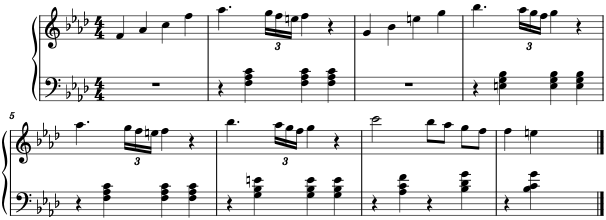
This is pretty close. We can make the function generate_beethoven_sonata() more concise, or more fine-tuned to generate a score closer to the original one, but I will stop here.
The most interesting thing is once we have captured the generative mechanism with function generate_beethoven_sonata(), we can supply other inputs to it to generate different music. For example,
melodic_pitch_motif = [65, 67, 72, 73, 79, 77]
melodic_duration_motif = [1, 1, 1, 1, 2, 2]
scale = [5, 7, 10, 0, 1]
harmonies = [
[5, 7, 8, 0],
[0, 1, 7, 10],
[5, 7, 8, 0],
[0, 1, 7, 10],
[5, 7, 8, 0],
[5, 7, 10, 1],
[0, 1, 7, 10]
]
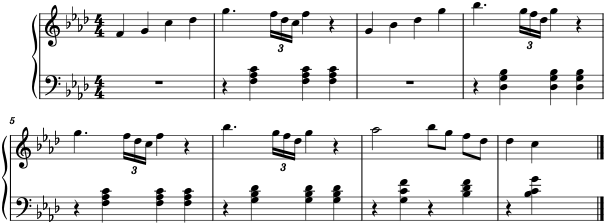
Update: here is a lovely interpretation by @miso_soup3.
This might be how a Japanese Beethoven would have composed it.
Discussion
Here are my responses to some comments on Hacker News.
Limitations
To be completely automatic, ch0p1n should be able to
- analyze
- generate
- manipulate
- select
- organize
musical materials to generate music.
Specifically, it should be able to analyze musical structures, generate core musical materials, manipulate these materials to produce more, select musically good materials, and organize them into semantically rather than syntactically correct music.
For now, ch0p1n can only provide a framework for manipulating given materials to generate music.
However, even with only this functionality, ch0p1n are powerful enough to produce interesting and non-trivial music.
Deep Learning
I have only very general knowledge of deep learning, but I think it is more promising than any other manual approach in automatic composition. I will spend time study it.
Terrible Result?
Some comments say the final generated music sounds terrible, which I can only partially agree.
All music pieces in this blog are generated with MuseScore. To make the music sound less mechanical or less terrible, you need to carefully adjust dynamics, tempos, pedals, etc. And even so, the music may still sound unsatisfactory. The original Beethoven’s sonata generated with MuseScore sounds bad even with dynamics and articulations added.
However, ch0p1n can only deal with pitch and durational aspects of music for now, but to make music sound good, you need to adjust a tremendous amount of variables. This is also why I said deep learning is more promising.
Some comments think the terribleness results from that ch0p1n can only generate syntactically correct music which may be musically meaningless. While I agree that ch0p1n has this limitation, I do believe in most cases, syntactically correct music is good enough to sound good.
I will try to generate more convincing music with ch0p1n in the future.
-
Nierhaus, G. (2009). Algorithmic Composition: Paradigms of Automated Music Generation. Springer Science & Business Media. ↩︎
-
Caplin, William E. (2013). Analyzing Classical Form: an Approach for the Classroom. Oxford and New York: Oxford University Press. ↩︎
-
Huron, D. (2001). Tone and voice: A derivation of the rules of voice-leading from perceptual principles. Music Perception, 19(1), 1-64. ↩︎
-
Pankhurst, T. (2008). SchenkerGUIDE: a brief handbook and website for Schenkerian analysis (p. 11). Routledge. ↩︎
-
Schoenberg, A., Stein, L., & Strang, G. (1967). Fundamentals of musical composition (p. 63). London: Faber & Faber. ↩︎